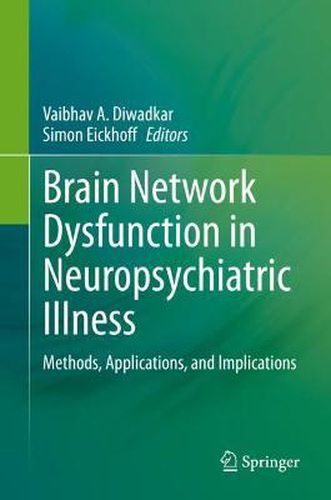Readings Newsletter
Become a Readings Member to make your shopping experience even easier.
Sign in or sign up for free!
You’re not far away from qualifying for FREE standard shipping within Australia
You’ve qualified for FREE standard shipping within Australia
The cart is loading…






This title is printed to order. This book may have been self-published. If so, we cannot guarantee the quality of the content. In the main most books will have gone through the editing process however some may not. We therefore suggest that you be aware of this before ordering this book. If in doubt check either the author or publisher’s details as we are unable to accept any returns unless they are faulty. Please contact us if you have any questions.
Brain network function and dysfunction is the dominant model for understanding how the brain gives rise to normal and abnormal behavior. Moreover, neuropsychiatric illnesses continue to resist attempts to reveal an understanding of their bases. Thus, this timely volume provides a synthesis of the uses of multiple analytic methods as they are applied to neuroimaging data, to seek understanding of the neurobiological bases of psychiatric illnesses, understanding that can subsequently aid in their management and treatment. A principle focus is on the analyses and application of methods to functional magnetic resonance imaging (fMRI) data. fMRI remains the most widely used neuroimaging technique for estimating brain network function, and several of the methods covered can estimate brain network dysfunction in resting and task-active states.
Additional chapters provide details on how these methods are (and can be) applied in the understanding of several neuropsychiatric disorders, including schizophrenia, mood disorders, autism, borderline personality disorder, and attention deficit hyperactivity disorder (ADHD). A final complement of chapters provides a collective overview of how this framework continues to provoke theoretical advances in our conception of the brain in psychiatry. This unique volume is designed to be a comprehensive resource for imaging researchers interested in psychiatry, and for psychiatrists interested in advanced imaging applications.
$9.00 standard shipping within Australia
FREE standard shipping within Australia for orders over $100.00
Express & International shipping calculated at checkout
This title is printed to order. This book may have been self-published. If so, we cannot guarantee the quality of the content. In the main most books will have gone through the editing process however some may not. We therefore suggest that you be aware of this before ordering this book. If in doubt check either the author or publisher’s details as we are unable to accept any returns unless they are faulty. Please contact us if you have any questions.
Brain network function and dysfunction is the dominant model for understanding how the brain gives rise to normal and abnormal behavior. Moreover, neuropsychiatric illnesses continue to resist attempts to reveal an understanding of their bases. Thus, this timely volume provides a synthesis of the uses of multiple analytic methods as they are applied to neuroimaging data, to seek understanding of the neurobiological bases of psychiatric illnesses, understanding that can subsequently aid in their management and treatment. A principle focus is on the analyses and application of methods to functional magnetic resonance imaging (fMRI) data. fMRI remains the most widely used neuroimaging technique for estimating brain network function, and several of the methods covered can estimate brain network dysfunction in resting and task-active states.
Additional chapters provide details on how these methods are (and can be) applied in the understanding of several neuropsychiatric disorders, including schizophrenia, mood disorders, autism, borderline personality disorder, and attention deficit hyperactivity disorder (ADHD). A final complement of chapters provides a collective overview of how this framework continues to provoke theoretical advances in our conception of the brain in psychiatry. This unique volume is designed to be a comprehensive resource for imaging researchers interested in psychiatry, and for psychiatrists interested in advanced imaging applications.